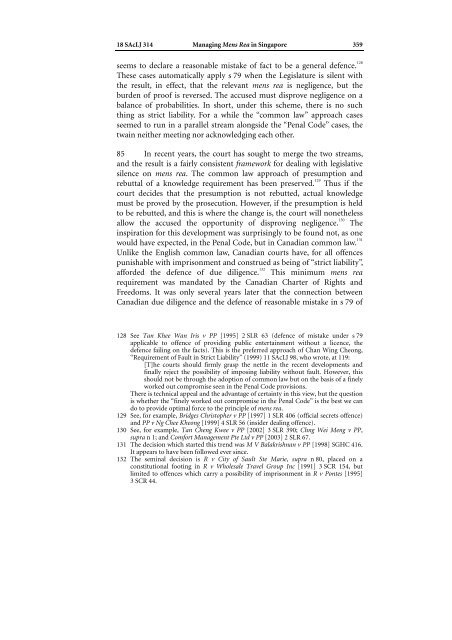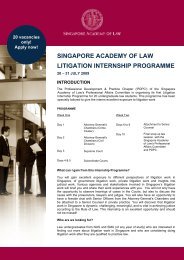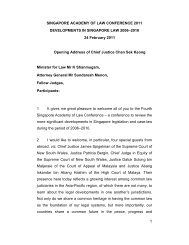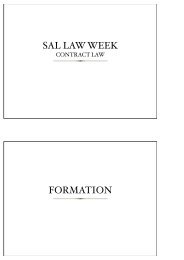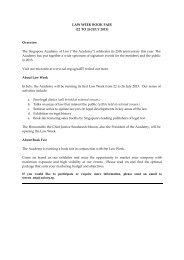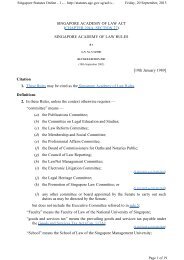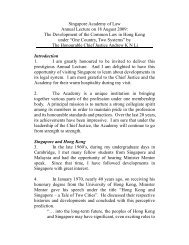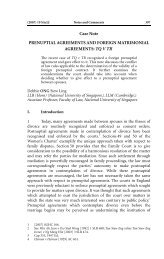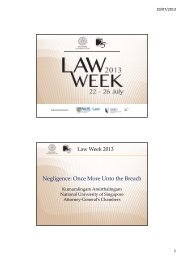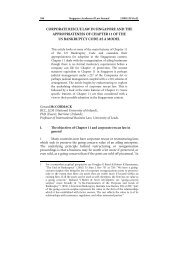2. Managing Mens Rea in Singapore - Singapore Academy of Law
2. Managing Mens Rea in Singapore - Singapore Academy of Law
2. Managing Mens Rea in Singapore - Singapore Academy of Law
Create successful ePaper yourself
Turn your PDF publications into a flip-book with our unique Google optimized e-Paper software.
18 SAcLJ 314 <strong>Manag<strong>in</strong>g</strong> <strong>Mens</strong> <strong>Rea</strong> <strong>in</strong> S<strong>in</strong>gapore 359seems to declare a reasonable mistake <strong>of</strong> fact to be a general defence. 128These cases automatically apply s 79 when the Legislature is silent withthe result, <strong>in</strong> effect, that the relevant mens rea is negligence, but theburden <strong>of</strong> pro<strong>of</strong> is reversed. The accused must disprove negligence on abalance <strong>of</strong> probabilities. In short, under this scheme, there is no suchth<strong>in</strong>g as strict liability. For a while the “common law” approach casesseemed to run <strong>in</strong> a parallel stream alongside the “Penal Code” cases, thetwa<strong>in</strong> neither meet<strong>in</strong>g nor acknowledg<strong>in</strong>g each other.85 In recent years, the court has sought to merge the two streams,and the result is a fairly consistent framework for deal<strong>in</strong>g with legislativesilence on mens rea. The common law approach <strong>of</strong> presumption andrebuttal <strong>of</strong> a knowledge requirement has been preserved. 129Thus if thecourt decides that the presumption is not rebutted, actual knowledgemust be proved by the prosecution. However, if the presumption is heldto be rebutted, and this is where the change is, the court will nonethelessallow the accused the opportunity <strong>of</strong> disprov<strong>in</strong>g negligence. 130The<strong>in</strong>spiration for this development was surpris<strong>in</strong>gly to be found not, as onewould have expected, <strong>in</strong> the Penal Code, but <strong>in</strong> Canadian common law. 131Unlike the English common law, Canadian courts have, for all <strong>of</strong>fencespunishable with imprisonment and construed as be<strong>in</strong>g <strong>of</strong> “strict liability”,afforded the defence <strong>of</strong> due diligence. 132This m<strong>in</strong>imum mens rearequirement was mandated by the Canadian Charter <strong>of</strong> Rights andFreedoms. It was only several years later that the connection betweenCanadian due diligence and the defence <strong>of</strong> reasonable mistake <strong>in</strong> s 79 <strong>of</strong>128 See Tan Khee Wan Iris v PP [1995] 2 SLR 63 (defence <strong>of</strong> mistake under s 79applicable to <strong>of</strong>fence <strong>of</strong> provid<strong>in</strong>g public enterta<strong>in</strong>ment without a licence, thedefence fail<strong>in</strong>g on the facts). This is the preferred approach <strong>of</strong> Chan W<strong>in</strong>g Cheong,“Requirement <strong>of</strong> Fault <strong>in</strong> Strict Liability” (1999) 11 SAcLJ 98, who wrote, at 119:[T]he courts should firmly grasp the nettle <strong>in</strong> the recent developments andf<strong>in</strong>ally reject the possibility <strong>of</strong> impos<strong>in</strong>g liability without fault. However, thisshould not be through the adoption <strong>of</strong> common law but on the basis <strong>of</strong> a f<strong>in</strong>elyworked out compromise seen <strong>in</strong> the Penal Code provisions.There is technical appeal and the advantage <strong>of</strong> certa<strong>in</strong>ty <strong>in</strong> this view, but the questionis whether the “f<strong>in</strong>ely worked out compromise <strong>in</strong> the Penal Code” is the best we cando to provide optimal force to the pr<strong>in</strong>ciple <strong>of</strong> mens rea.129 See, for example, Bridges Christopher v PP [1997] 1 SLR 406 (<strong>of</strong>ficial secrets <strong>of</strong>fence)and PP v Ng Chee Kheong [1999] 4 SLR 56 (<strong>in</strong>sider deal<strong>in</strong>g <strong>of</strong>fence).130 See, for example, Tan Cheng Kwee v PP [2002] 3 SLR 390; Chng Wei Meng v PP,supra n 1; and Comfort Management Pte Ltd v PP [2003] 2 SLR 67.131 The decision which started this trend was M V Balakrishnan v PP [1998] SGHC 416.It appears to have been followed ever s<strong>in</strong>ce.132 The sem<strong>in</strong>al decision is R v City <strong>of</strong> Sault Ste Marie, supra n 80, placed on aconstitutional foot<strong>in</strong>g <strong>in</strong> R v Wholesale Travel Group Inc [1991] 3 SCR 154, butlimited to <strong>of</strong>fences which carry a possibility <strong>of</strong> imprisonment <strong>in</strong> R v Pontes [1995]3 SCR 44.


